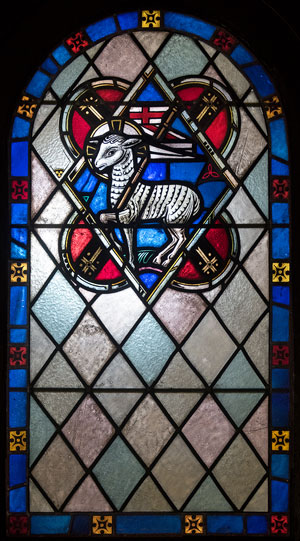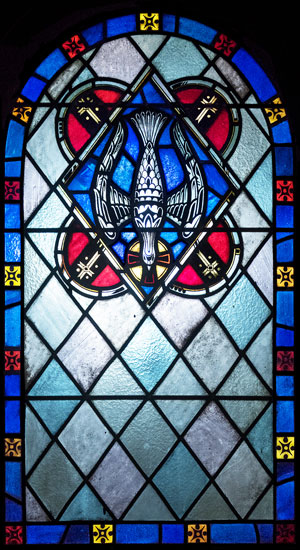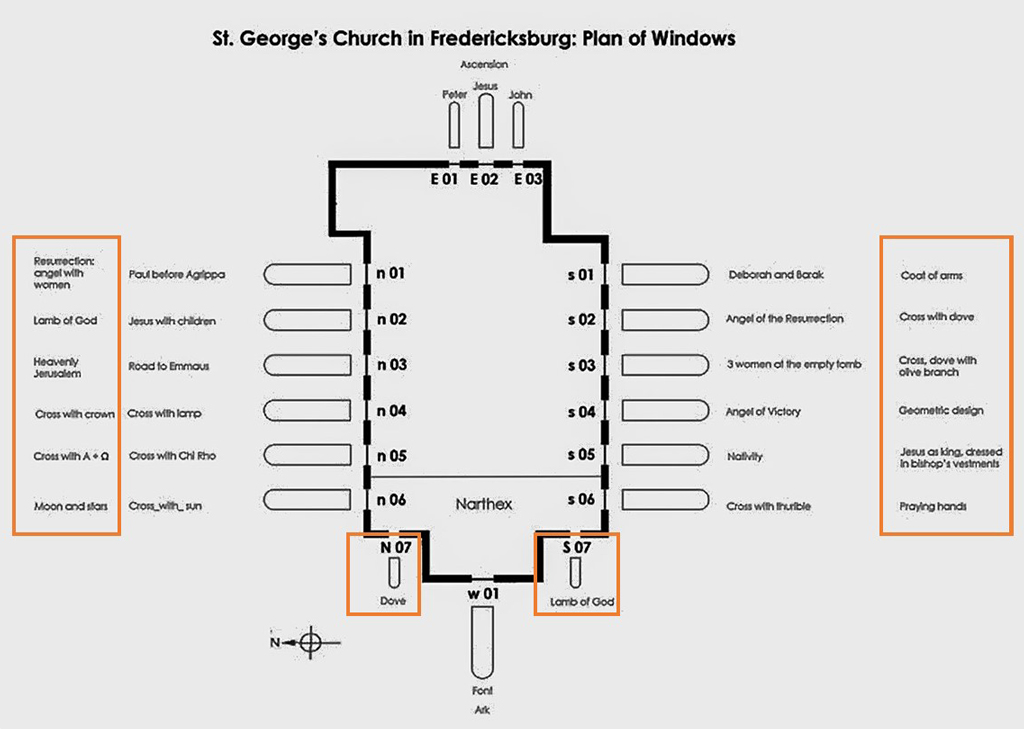
The upper windows are generally only open to the public for special tours due to accessibility to the gallery. However, this tour provides a tour of these normally inaccessible windows.
Quick Links
South (Right)
1. Washington Coat of Arms
2. Cross with Dove
3. Cross, Dove with Olive Branch
4. Geometric Design
5. Christ the King
6. Praying Hands
North (Right)
1. Resurrection Angel with Women
2. Lamb of God
3. Heavenly Jerusalem
4. Cross and Crown
5. Cross Alpha and Omega
6. Moon and Stars
7. Small Windows
Washington Coat of Arms
Dedication: To the memory of Mary Ball Washington, Mother of George Washington, by the Daughters of the American Revolution
Maker/Date: Colgate Art Glass Co., New York, 1907
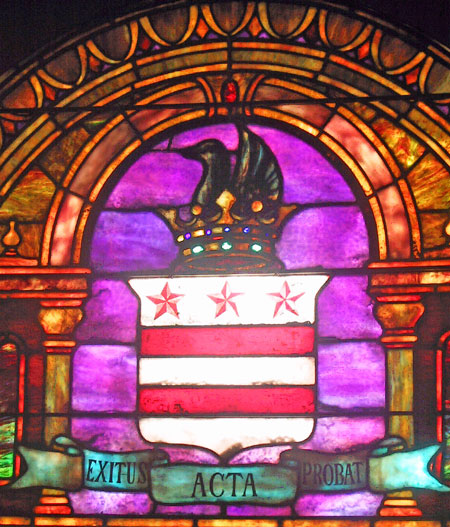
Description: The design of the Washington Coat of Arms (three red stars over two horizontal red bars on a white field) is often said to have inspired the Stars and Stripes flag and has been used since 1938 as the coat of arms and flag of the District of Columbia. It is also found on the Purple Heart. The shield is topped with a crown and bird. The phrase “Exitus Acta Probat” is Latin for “the result validates the deeds” or, more accurately, “the ends justify the means.”
Cross with Dove
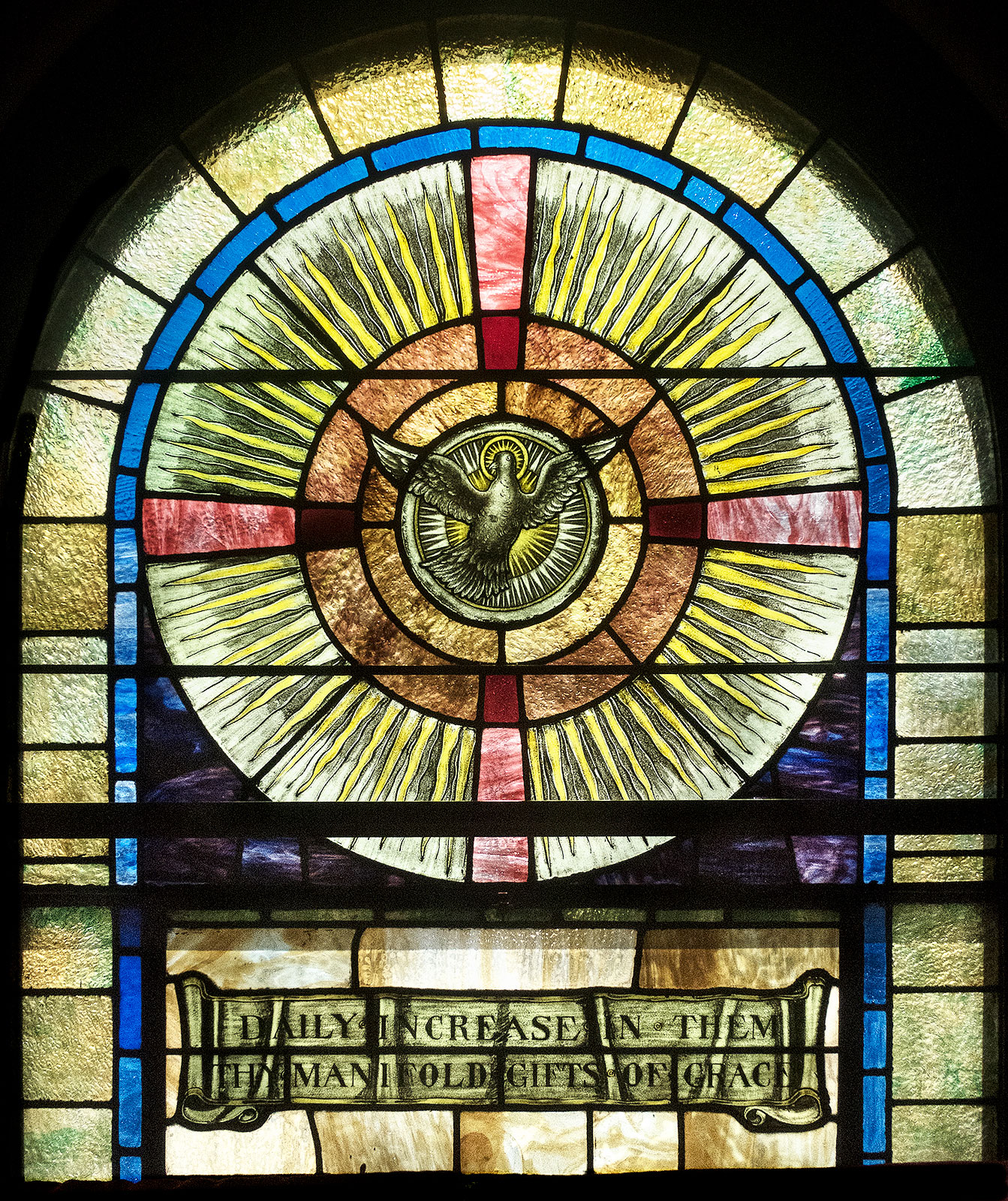
Subject: Dove/Holy Spirit
Inscription: “Daily Increase In Them Thy Manifold Gifts of Grace”
Donor: Wellington and Victoria Stevens Wallace
Maker/Date: Charles Hogeman, 1908
Description – The inscription is from the 1789 Prayer Book and more specifically the “Order of Confirmation”:
“ALMIGHTY and everliving God, who hast vouchsafed to regenerate these thy servants by Water and the Holy Ghost, and hast given unto them forgiveness of all their sins; Strengthen them, we beseech thee, O Lord, with the Holy Ghost, the Comforter; and daily increase in them thy manifold gifts of grace; the spirit of wisdom and understanding, the spirit of counsel and ghostly strength, the spirit of knowledge and true godliness; and fill them, O Lord, with the spirit of thy holy fear, now and forever. Amen.”
The Dove is the Christian symbol of the Holy Ghost from the words of John the Baptist in John 1:32- “And John bare witnessing, and said, I saw the Spirit coming down a from heaven like a dove and resting on him.” In this sense, it appears in representations of the Annunciation, Baptism of Christ and Paul. A dove issuing from a nun’s mouth symbolizes her soul rising to heaven. The dove of Noah’s Ark became the symbol of good tidings and peace. From Rome, doves represent love and constancy.
Techniques – The Wallace windows use similar glass around center symbols arranged in five rows of stone with the central theme in the middle. Surrounding the symbol are two concentric circles of stones. Within each row are different shapes of glass. The effect is traditional without any special treatment of the glass or painting.
Cross, Dove with Olive Branch
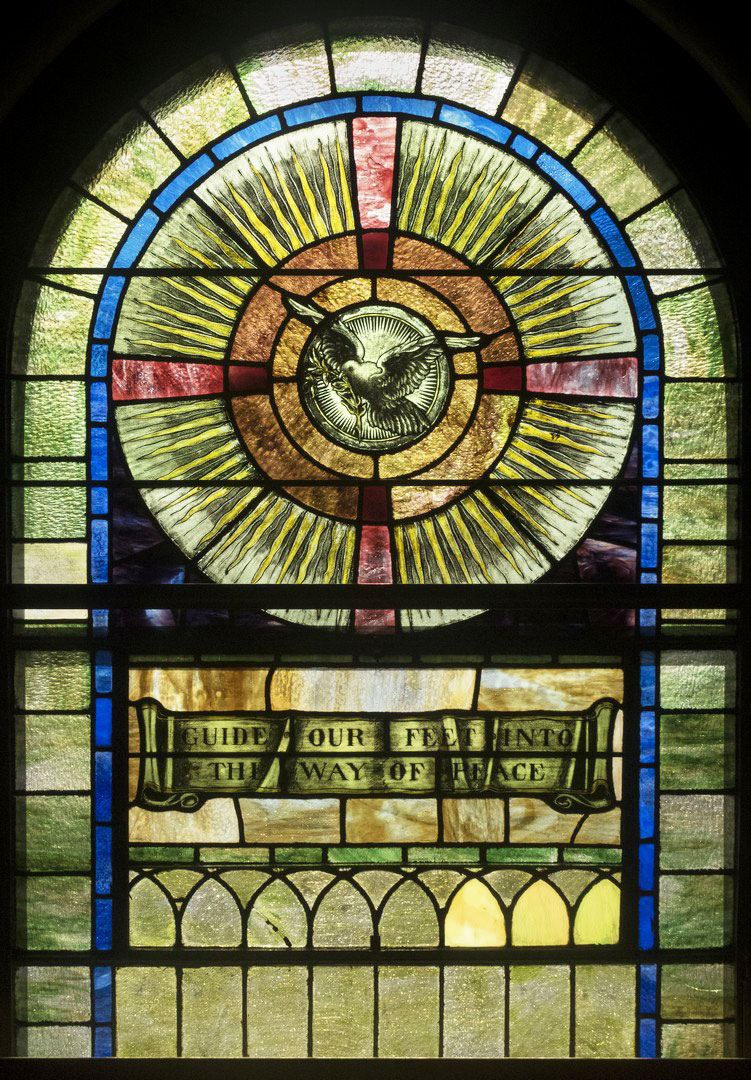
Subject: Dove/Olive Branch
Inscription: “Guide Our Feet Into The Way of Peace”
Donor: Wellington and Victoria Stevens Wallace
Maker/Date: Charles Hogeman, 1908
The verse derives from Luke 1:76-80, part of the prophecy of the coming of Jesus:
"And you, child, will be called prophet of the Most High, for you will go before the Lord to prepare his ways, to give his people knowledge of salvation through the forgiveness of their sins,because of the tender mercy of our God by which the daybreak from on high will visit us to shine on those who sit in darkness and death’s shadow, to guide our feet into the path of peace. The child grew and became strong in spirit, and he was in the desert until the day of his manifestation to Israel."
Techniques -The Wallace windows use similar glass around a center symbols arranged in five rows of stone with the central theme in the middle. Surrounding the symbol are two concentric circles of stones. Within each row are different shapes of glass. The effect is traditional without any special treatment of the glass or painting.
The now ubiquitous peace symbol of a dove and olive branch has an unusual history. Though it was initially used by Christians, it is derived from a number of sources. The Biblical story of Noah and the Flood tells of a dove returning to the Arc with a freshly plucked olive leaf. The leaf reveals proof of land, the end of the flood, and for Christians the parallel of baptism. In this context the symbol did not, however, specifically carry the connection of peace.
Christians apparently derived the dove and olive branch as a symbol of peace from two sources. In the New Testament, the Spirit of God that descended upon Jesus during his baptism is compared to a dove. In early Christian art the dove is often used to represent the peace of the soul.
The use of the olive branch, on the other hand, dates back to ancient Greece, five centuries before Christ. Irene, the goddess of peace, was said to be very fond of the olive. To the ancient Greeks the olive tree represented abundance and was also believed to be able drive away evil spirits.
In the 5th century, by which time a dove with an olive branch had become established as a Christian symbol of peace, St Augustine wrote in On Christian Doctrine that, “perpetual peace is indicated by the olive branch (oleae ramusculo) which the dove brought with it when it returned to the ark.”
In more modern times, it is not until 1949, when Picasso created the poster for the World Peace Congress that the symbol regained prominence as the great symbol of peace.
Geometric Design
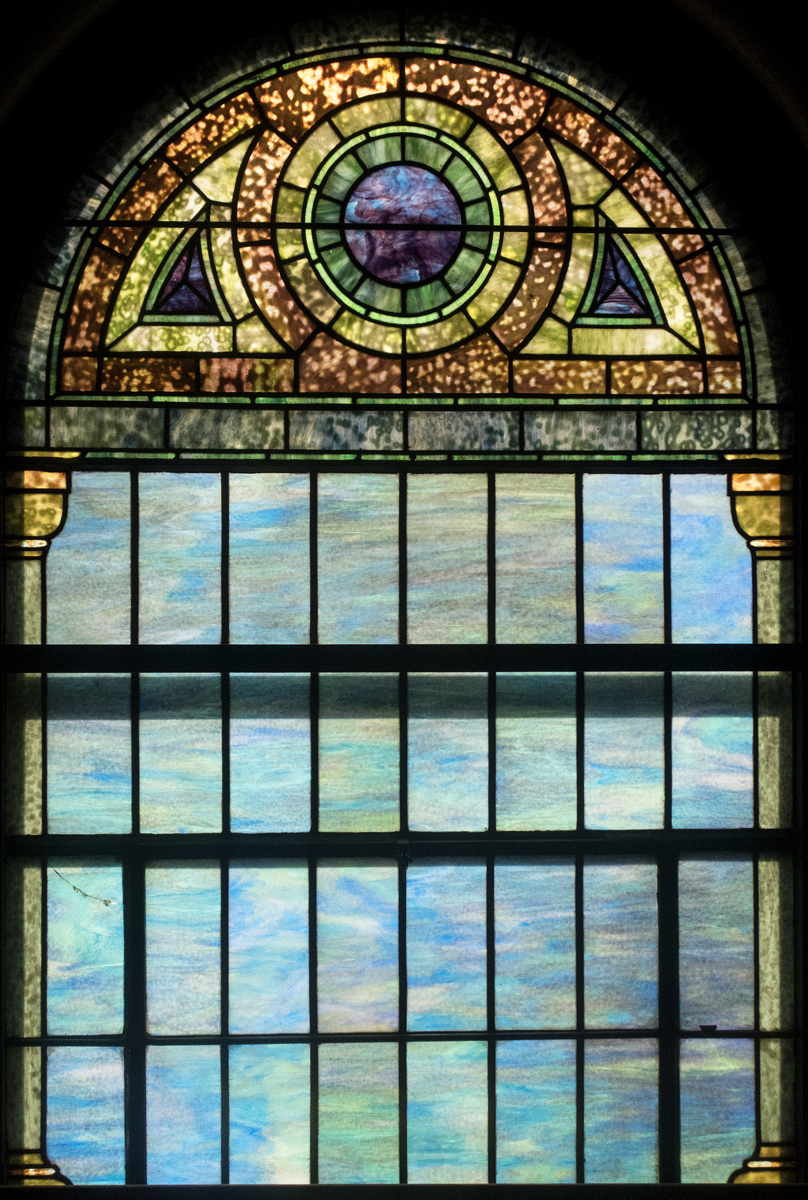
Upper Subject: Ornamental
This is a mosaic pattern that was either unfinished or meant to be kept plain. We are not sure of the maker or the date.
Christ the King or Jesus as King Dressed in Bishop’s Vestments
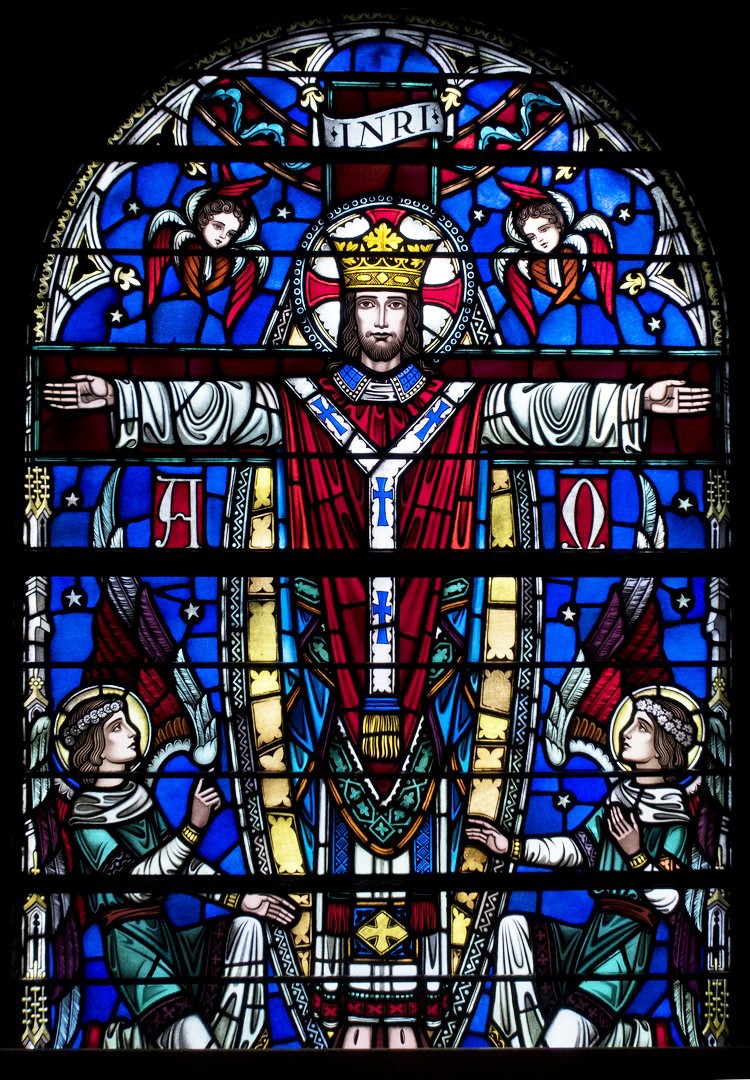
Subject: Christ the King.
We celebrate Christ the King Sunday as the last Sunday of Ordinary Time the week before we begin Advent. It is the switch in the Liturgy between Years A, B, and C.
Inscription: none
Dedication: In memory of Sue Young Lallande and John James Lallande, Louise Lallande Hoyt and Lindley Murray Ferris
Maker/Date: Wilbur Herbert Burnham, Boston, Massachusetts, 1943
Background –
The earliest Christians identified Jesus with the predicted Messiah of the Jews. The Jewish word “messiah,” and the Greek word “Christ,” both mean “anointed one,” and came to refer to the expected king who would deliver Israelfrom the hands of the Romans. Christians believe that Jesus is this expected Messiah. Unlike the messiah most Jews expected, Jesus came to free all people, Jew and Gentile, and he did not come to free them from the Romans, but from sin and death. Thus the king of the Jews, and of the cosmos, does not rule over a kingdom of this world.
Christians have long celebrated Jesus as Christ, and his reign as King is celebrated to some degree in Advent (when Christians wait for his second coming in glory), Christmas (when “born this day is the King of the Jews”), Holy Week (when Christ is the Crucified King), Easter (when Jesus is resurrected in power and glory), and the Ascension (when Jesus returns to the glory he had with the Father before the world was created).
The four Gospel writers of the Bible’s Christian Testament all refer to Christ, after His Resurrection, variously as “King of Kings“; ”King of Glory“; “All Powerful”; “All Ruler”; “Lord of Lords” and similar lofty, Imperial-style titles. Obviously, this was against the backdrop of the presence of the Holy Land’s rulers at the time, the Roman Emperors.
The celebration of Christ the King in modern times came from the Catholics in the 20th century. Pope Pius XI wanted to specifically commemorate Christ as king, and instituted the feast in the Western calendar in 1925. Pius connected the denial of Christ as king to the rise of secularism. Secularism was on the rise, and many Christians, even Catholics, were doubting Christ’s authority, as well as the Church’s, and even doubting Christ’s existence. Pius XI, and the rest of the Christian world, witnessed the rise of dictatorships in Europe, and saw Catholics being taken in by these earthly leaders
Pius hoped the institution of the feast would have various effects. They were:
- That nations would see that the Church has the right to freedom, and immunity from the state.
- That leaders and nations would see that they are bound to give respect to Christ.
- That the faithful would gain strength and courage from the celebration of the feast, as we are reminded that Christ must reign in our hearts, minds, wills, and bodies.
Description-
The upper subject projects the baby Jesus into Christ the King image, in Bishops’ vestments.
Jesus with crown outstretched arms is in the shape of the cross. Above Jesus INRI stems from the Latin phrase ‘Iesus Nazarenus Rex Iudaeorum’ meaning ‘Jesus of Nazareth, King of the Jews’.
He is flanked at the top with two seraphs and fleur de lis. The word “seraphs” means “burning ones” or nobles. They are also sometimes called the ‘ones of love’ because their name might come from the Hebrew root for ‘love’. They are only fully described in the Bible on one occasion. This is in the book of the prophet Isaiah, when he is being commissioned by God to be a prophet and he has a vision of heaven. There are six wings shown but only two are used for flying.
Jesus is inset in an oval design. As with the lower window, the yellow color accentuates Jesus, now an adult. Red from the cherubs, the Celtic cross behind Jesus and his vestments grouped together are also in the shape of a cross and provide additional emphasis on Jesus. Jesus’ head is surrounded on the borders by medieval pointed arches.
The two symbols in the middle are Alpha and Omega from Revelation 21:- “I am Alpha and Omega, the beginning and the end.” It comes in a passage dealing with the end of history. So Christ is the Alpha and Omega of all things.”
Below Alpha and Omega are two angels in medieval costume with the wings outreached. The color green for youth and immortality. Angels can be considered immortal. In Luke 20:35-36, it is written”..but those who are considered worthy of a place in that age and in the resurrection from the dead neither marry nor are given in marriage. Indeed they cannot die anymore, because they are like angels and are children of God, being children of the resurrection.”
Praying Hands
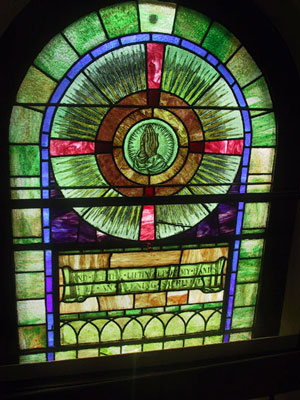
Upper Subject: Hands in Prayer
Inscription: “And The Lifting Up Of My Hands Be As An Evening Sacrifice”
Dedication: Wellington and Victoria Stevens Wallace
Maker/Date: Charles Hogeman, Easter, 1908
Description: “And The Lifting Up Of My Hands Be As An Evening Sacrifice”
The scripture is also from Psalm 141:2
And the lifting up of my hands as the evening sacrifice. Whatever form his prayer might take his one desire was that it might be accepted of God. Prayer is sometimes presented without words by the very motions of our bodies: bent knees and lifted hands are the tokens of earnest, expectant prayer. Certainly work, or the lifting up of the hands in labour, is prayer if it be done in dependence upon God and for his glory: there is a hand prayer as well as a heart prayer, and our desire is that tiffs may be sweet unto the Lord as the sacrifice of eventide. Holy hope, the lifting up of hands that hang down, is also a kind of worship: may it ever be acceptable with God. The Psalmist makes a bold request: he would have his humble cries and prayers to be as much regarded of the Lord as the appointed morning and evening sacrifices of the holy place. Yet the prayer is by no means too bold, for, after all, the spiritual is in the Lord’s esteem higher than the ceremonial, and the calves of the lips are a truer sacrifice than the calves of the stall. So far we have a prayer about prayer: we have a distinct supplication in the two following verses.
Techniques – The Wallace windows use similar glass around a center symbols arranged in five rows of stone with the central theme in the middle. Surrounding the symbol are two concentric circles of stones. Within each row are different shapes of glass. The effect is traditional without any special treatment of the glass or painting.
Techniques: The Wallace windows use similar glass around center symbols arranged in five rows of stone with the central theme in the middle. Surrounding the symbol are two concentric circles of stones. Within each row are different shapes of glass. The effect is traditional without any special treatment of the glass or painting.
N01
Resurrection Angel with Women
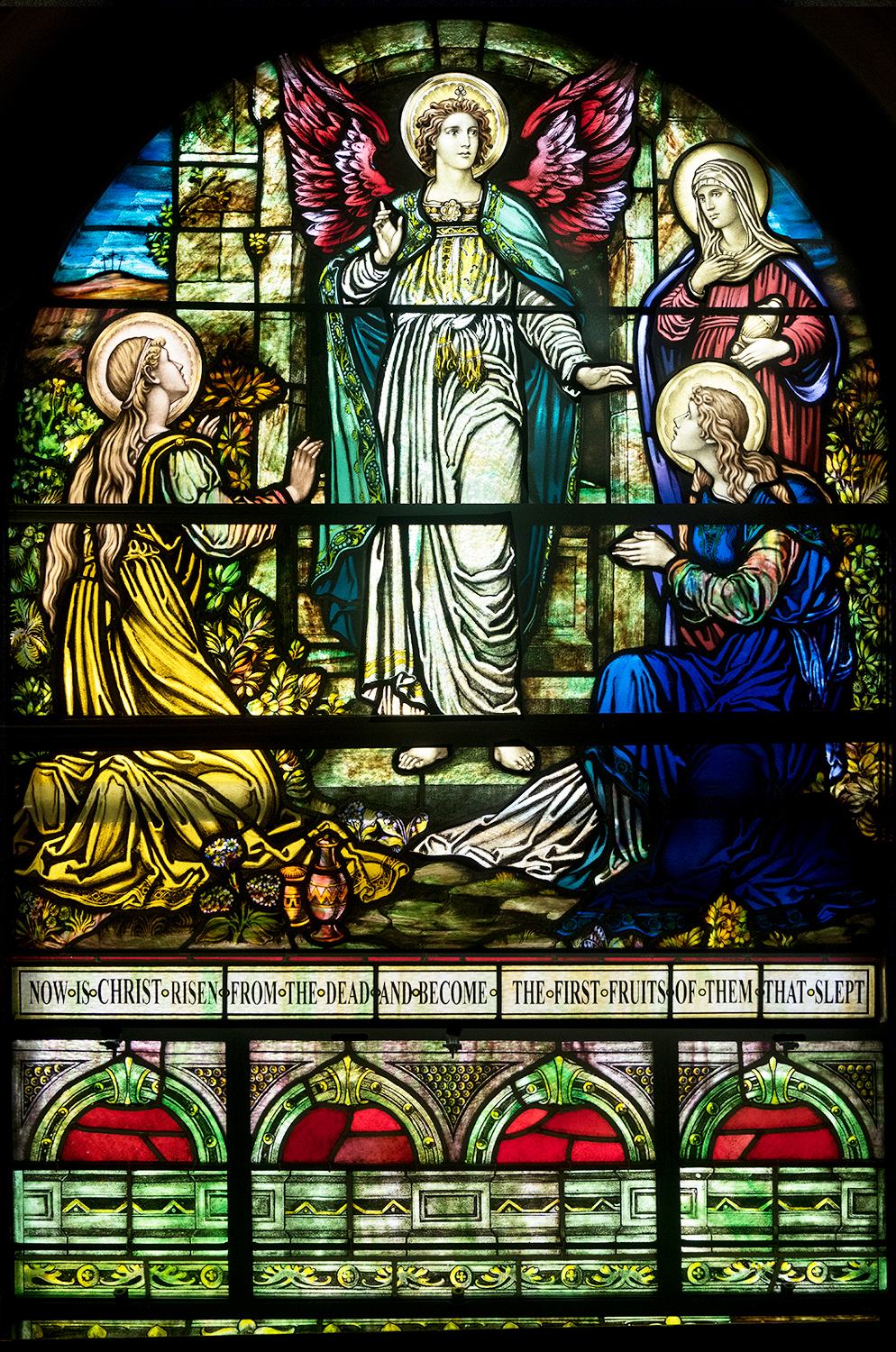
Upper Subject: Angel at the Empty Tomb
Description: Window was reported to be in position by the Daily Star in an article on March 28, 1908
Donor: Wistar Wallace was responsible for this window through his will and for investment in what would become the Wallace Library just across George Street.
Upper Inscription: “Now Is Christ Risen From The Dead And Become The First Fruits Of Them That Slept” (1 CORINTHIANS 15:20).
The Resurrection subject of this window is the same as The Resurrection Angel at the Empty Tomb. The window depicts the shock of the tomb being open and Jesus not being there. As with that window, the story is told through the Gospel of Mark.
The figures are positioned differently than in our empty tomb window (“Three Women at the Tomb”) and they are solitary – there is no comforting between Salome and Mary mother of James. Mary Magdalene is on the left with the longer hair. Mary the mother of James is traditionally depicted in blue and she is praying. Salome is carrying the anointing vase perfumes and ointments to perform their own rites on Jesus’ body in preparation of burial, traditionally performed by Jewish women. The angel is clearly male and adheres to Mark’s account wearing robes of white but is not seated. However, there are overtones of the book of John with Mary Magdalene as she is reaching out to touch the angel as she will try to do with Jesus. Mary the mother of James clearly has the most disbelief. The angel is the center of attention as compared with the other window where it was split between the Angel and Mary Magdalene. As it is, there is less dramatic tension.
Mary the mother has a halo and is praying fitting Luke’s account of a praying woman. Salome is transfixed, staring at the vacant tomb, in shock while at the same time comforting Mary the mother. They function as important witnesses of the event. At the bottom of the window is the white burial garment, more vases and white flowers which may be lilies.
N02
Lamb of God
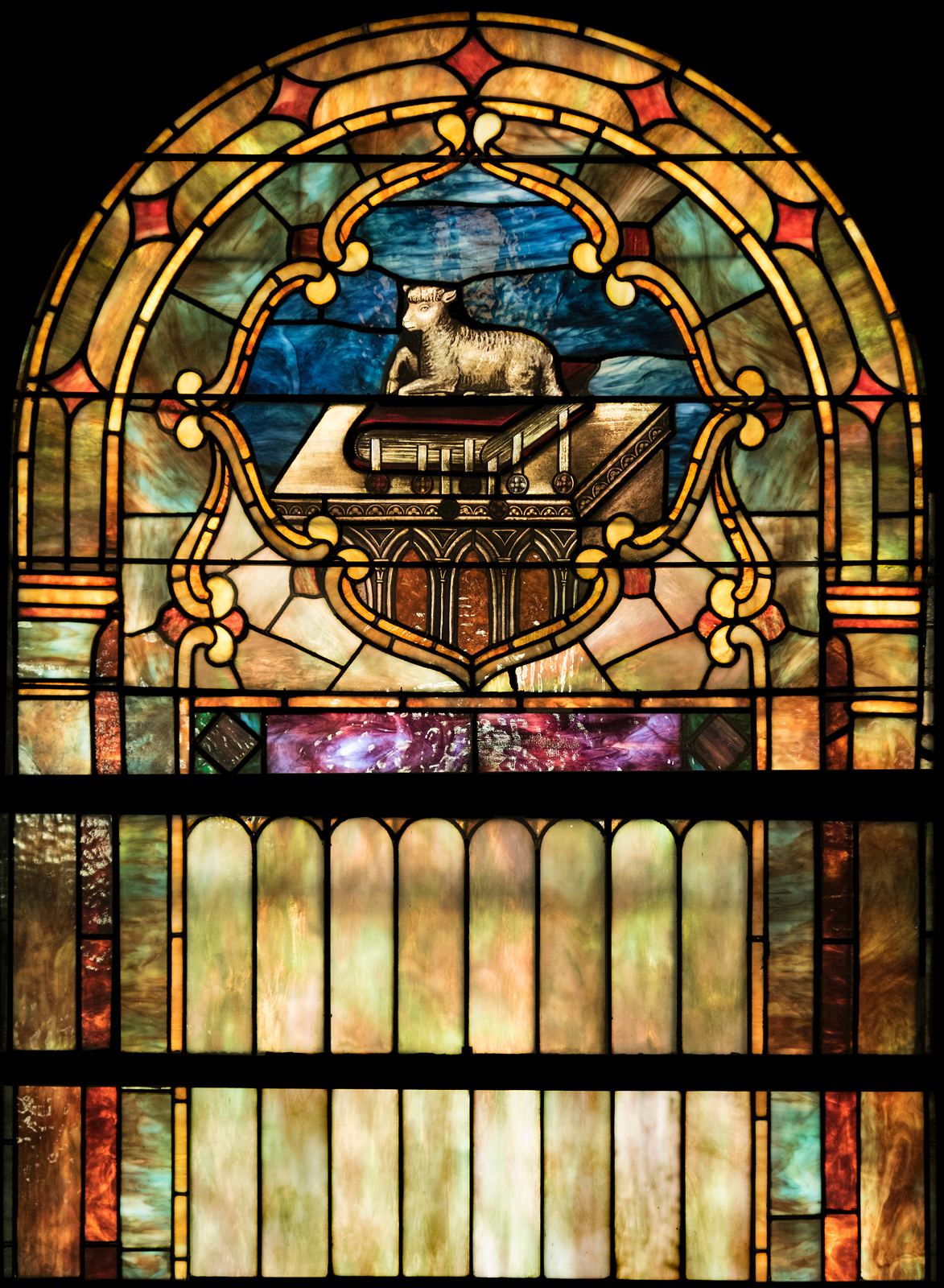
Subject: Lamb
Dedication: In memory of Marshall Carter Hall by St. George’s Sunday School
Maker/Date: Colgate Art Glass Co., New York, 1907
“Lamb of God” was a description of Jesus first used by John the Baptist. “Behold the Lamb of God, who takes away the sin of the world.” (John 1:29)
1:Peter:20 “Christ, a lamb without blemish or defect.”
1 Corinthians 5:7 Jesus is “our Passover lamb.”
Jesus is seen as the sacrificial lamb going to his death but one that has triumphed. A lamb is sacrificed at the Jewish ceremony of Passover.
In the story of Exodus, God planned to compel Pharoah to release the people of Israel from slavery by killing the firstborn of each Egyptian household. He told the people of Israel to sacrifice lambs and use their blood to mark their doorposts so that by that sign God would know to pass over their homes and not take the firstborn.
Jesus died at twilight on Passover, the time God told the Israelites that lamb should be sacrificed (John 19:4/ Exodus 12:6).
Lamb often shown in a position of triumph, standing with its leg hooked around the pole of a flag made up of a red cross on a white background and topped with another cross.
The Lamb can be shown as lamb with feet tied showing the future sacrifice.
The Lamb or ram appears in Jewish writing about the apocalypse at the end of time as the agent of God who would crush evil and save God’s people. In the book of Revelation, John saw a lamb and a book with 7 seals. When the lamb opened the seals, it ushered in the final apocalypse. Thus if a lamb is near a book from which 7 seals are shown, it is a reference to this event.
N03
Heavenly Jerusalem
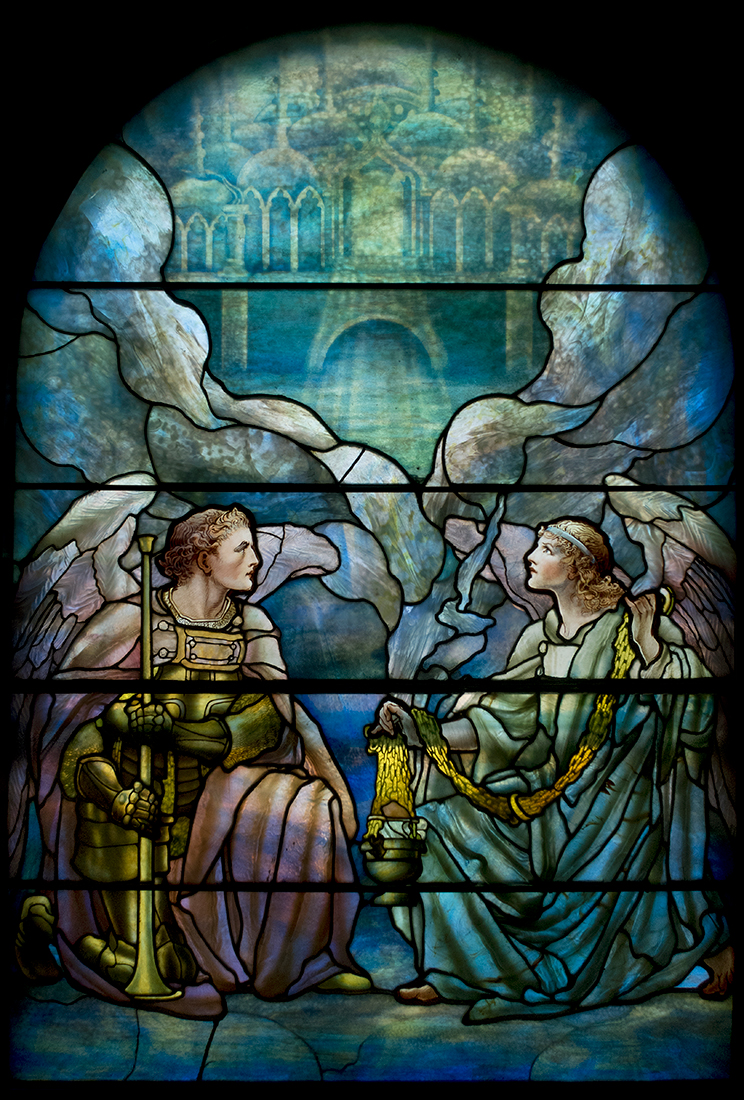
Upper Subject: Angels with Trumpet and Incense
Inscription: none
Dedication: In memory of Rawleigh W. Downman, 1860-1881 and James H. Downman, 1862-1911, sons of William Yates and Mary Ann Downman.
Maker/Date: Tiffany Studios, New York, 1912. This was the first Tiffany installed at St. George’s in 1912.
Description: Tiffany Studios produced three windows for Saint George’s Episcopal Church between 1912 and 1917. Each was intended as a memorial to specific members of the congregation, the earliest being the double window installed in 1912 on the left side of the nave.
Unlike the other Tiffany windows at St. George’s where only the lower portion of the window was created by Tiffany, this window has two separate Tiffany windows.
Donor: Mary Ann Downman was 90 years old in 1923, living in the same home that she was married and was the oldest person in Fredericksburg at the time.
She had six children, three that predeceased her. One child Rev John Yates Downman (1858-1949) became rector at St. Paul’s Episcopal in Richmond. The window was dedicated to two of her sons who had predeceased her. Rawleigh Downman died at age 21 visiting an uncle in Baltimore when he died. James Downman was a successful New York businessman who had suffered a stroke and returned to his sister Nannie’s home. There he was the victim of a hunting accident.
Description – The subject of this window is from the Book of Revelation 9:13 – “The sixth angel blew his trumpet; and I heard a single voice speaking from among the horns of the golden incense altar which is in the presence of God.”
There are seven trumpets in Revelation, each signaling the issuing of God’s judgment on earth. Angels bring God’s judgment on earth in Revelation. The blowing of these trumpets may correspond to the New Moon (or New Month) festivals in the Old Testament. Each new moon trumpet blowing was understood as a day of judgment in miniature, which warned people to prepare for the final judgment ushered in by the Feast of Trumpets and to call people back to a covenant relationship with God. When the seventh trumpet blew, it was to announce the Day of Atonement was at hand.
Before the seventh angel blew his trumpet in Revelation 11, John was asked by a mighty angel (with right foot on the sea and left foot on the land) to eat the scroll telling of the things to happen (first tasting like honey, then souring his stomach) and yet to continue to prophesy further. John was told that the “holy city” (Jerusalem) would be trampled for “42 months,” during which two prophets/witnesses would tell about God, then would be killed, and would rise to heaven after 3 1/2 days — with an earthquake collapsing a tenth of the city.
This image captures the calm before the storm— the angel on the left is the seventh trumpeter, and the angel on the right bears incense. Behind the kneeling angels, billowing cloud rises up, parting at the top to reveal a glistening vision of Jerusalem. The hair and faces are painted with reddish hair that is particularly noticeable.
Techniques – The upper window shows the city of Jerusalem, coming down from heaven, emerging from a backdrop of the opalescent glass of blues, browns, and greens. The Jerusalem image fades into the background. The city shows buildings with columns and onion skin domes.
The city was painted onto a sheet of colored glass with enamel. A sheet of spotted glass was then laid or plated on top, creating a sense of sunlit distance. The spotted glass was made by adding fluorine during the firing process— the fluorine crystallized and caused the spots. Drapery glass is used to produce ripples of varying hues and tints in the angels’ gowns. This type of glass has been bent and folded to produce ripples that create an illusion of depth. The solemn pose of the angels contrasts with the iridescent glimmer of the city that hovers above, instilling the design with surreal grandeur and a sense of what is to come.
N04
Cross and Crown
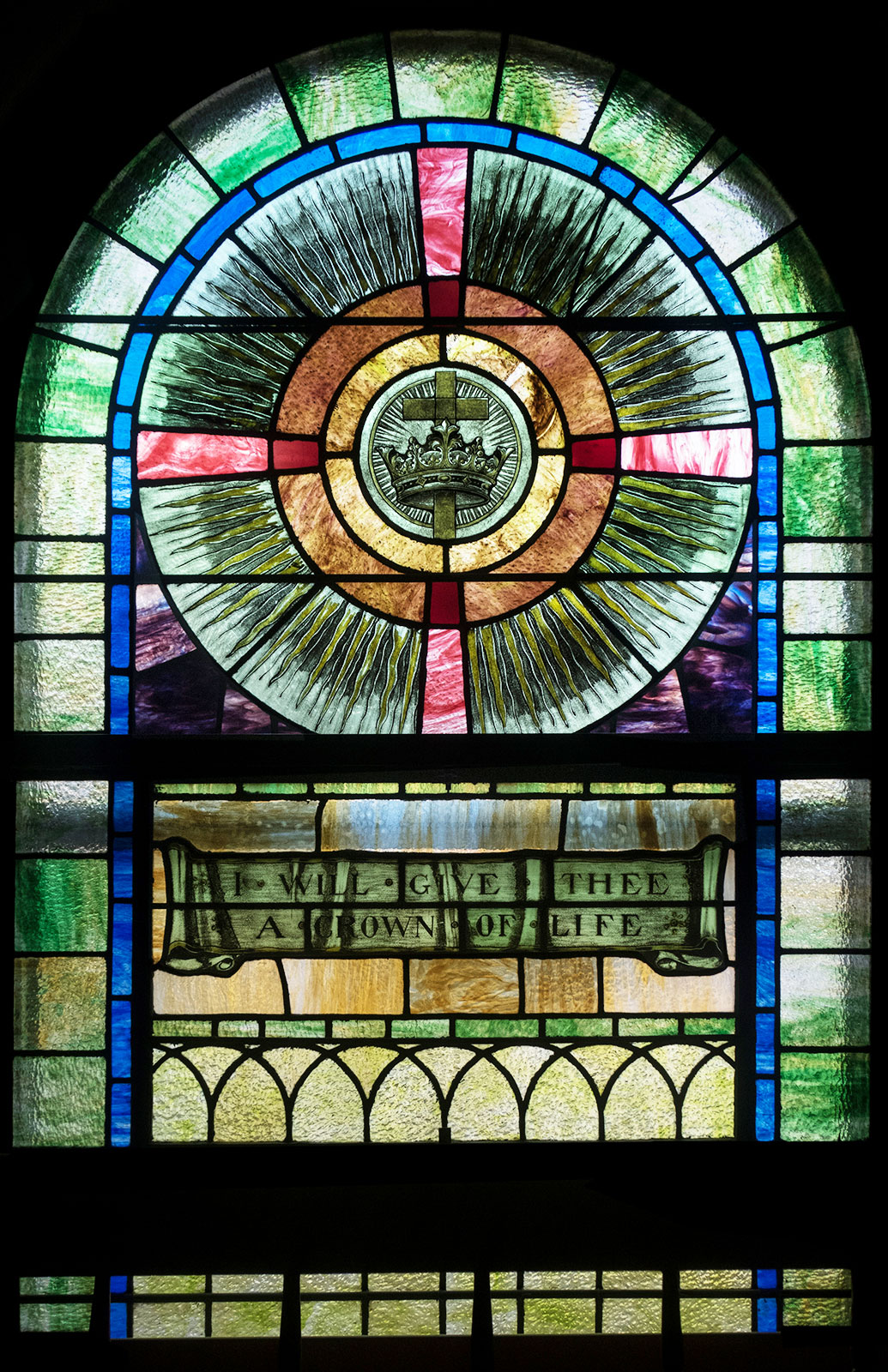
Upper Subject: Cross and Crown
Inscription: “I Will Give Thee A Crown Of Life”
Donor: Wellington and Victoria Stevens Wallace
Maker/Date: Charles Hogeman, Easter, 1908
This verse is from Revelation 2:10. John is writing letters to 7 Churches – this is part of the letter to Smyrna.
There are three crowns specifically mentioned in the New Testament. They are the crown of righteousness, the crown of glory and the crown of life.
“Do not be afraid of what you are about to suffer. I tell you, the devil will put some of you in prison to test you, and you will suffer persecution for ten days. Be faithful, even to the point of death, and I will give you the Crown of Life. He who has an ear, let him hear what the Spirit says to the churches. He who overcomes will not be hurt at all by the second death.”
The Christians in Smyrna must not be afraid. They are certain to suffer. *Satan will put some of them into prison. The testing is the work of God.
Prison in those days was not punishment. It was a place of waiting. People waited for a decision on their crimes. Whatever the result, they would only spend a short time in prison.
These troubles will last ten days. Ten days was the period of Daniel’s testing (Daniel 1:12-15). This may refer to the end of their suffering. It will last only for a short time. It will be a hard test but it will end. God speaks the last word (see James 1:12).
The Christian message was not popular in Smyrna. They did not approve of the Christian way of life, with its high standards. He asks them to be faithful even if they have to die.
The Crown of life is a reference to eternal life. The example is Christ who knew the pain of death but won the “victory over pain and death.”
The crown was not the crown that kings and queens wear but closer to the idea of a prize and a sign of victory which was appropriate for Smyrna which had famous sports games.
N05
Cross Alpha and Omega
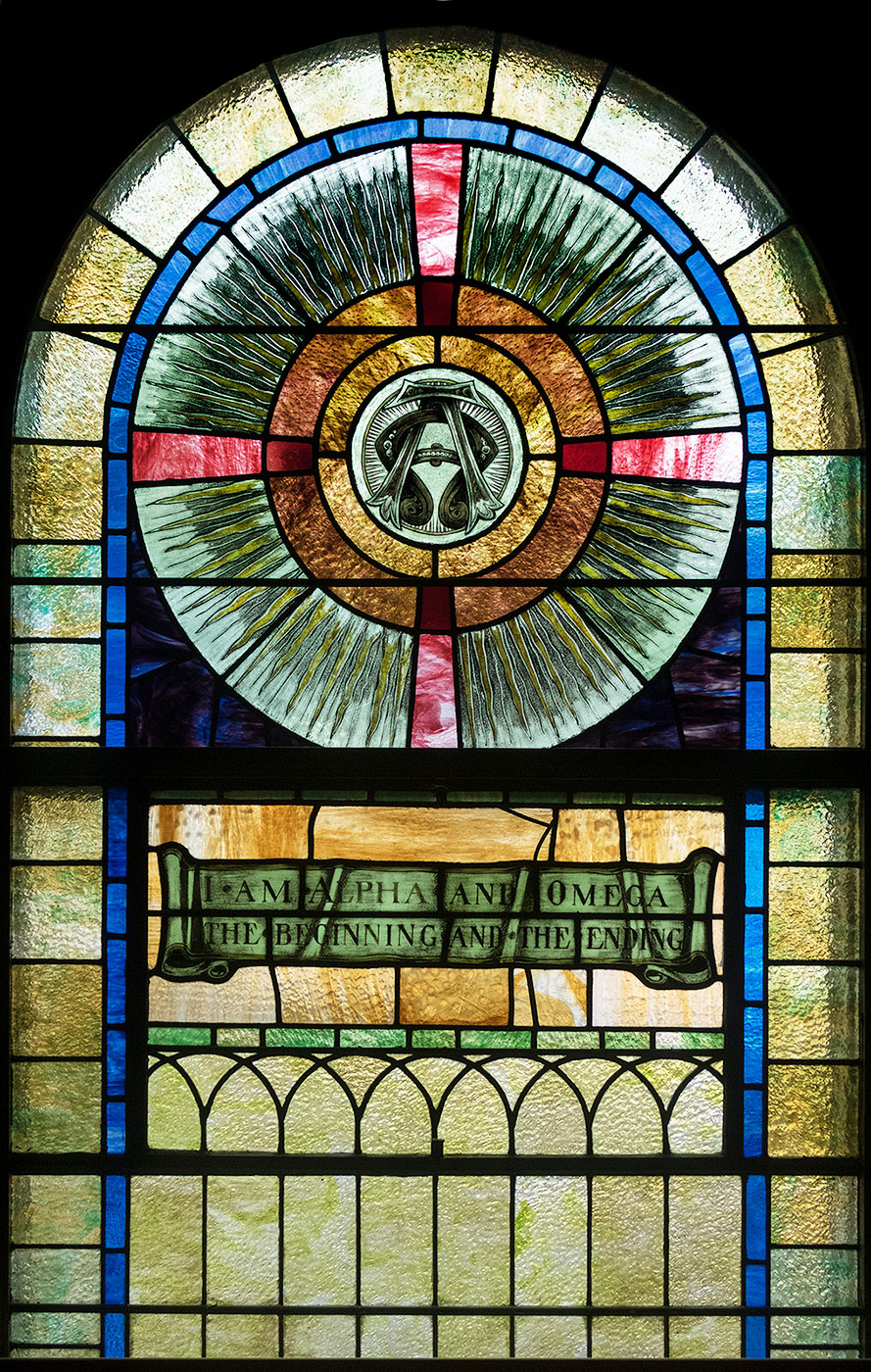
Upper Subject: Alpha and Omega
Inscription: “I Am Alpha And Omega, The Beginning And The Ending”
Donor: Wellington and Victoria Stevens Wallace
Maker/Date: Charles Hogeman, Easter, 1909
Upper Description – This is from the book of Revelation 1:8.
God introduces himself as ‘the “Alpha and Omega.” “Alpha” is the first letter of the Greek alphabet. “Omega” is the last letter. The entire quote “I am the Alpha and the Omega,” says the Lord God, “who is and who was and who is to come, the Almighty.” God gave the revelation to Jesus to show his servants what must soon take place.
Revelation shows us that God is sovereign over human history, that God is both the beginning and the end is particularly appropriate to this book. He is the end of history. He is the Lord of all that comes in between. He is the Lord King of all the ages. No person, no ruler, no country can oppose the Lord King. Nine times in this book, God has the name ‘Almighty’.
This designation of Alpha and Omega is repeated in 21:6, 22:13. Jesus came to earth and died on the cross and he is now exalted at the right hand of God and intercedes for us and he is coming again in power and glory to claim his own. When he returns he will consummate this present age and the righteous will rise from the dead and there will be a new age with a new heaven and new earth.
Techniques – The Wallace windows use similar glass around center symbols arranged in five rows of stone with the central theme in the middle. Surrounding the symbol are two concentric circles of stones. Within each row are different shapes of glass. The effect is traditional without any special treatment of the glass or painting.
N06
Moon and Stars
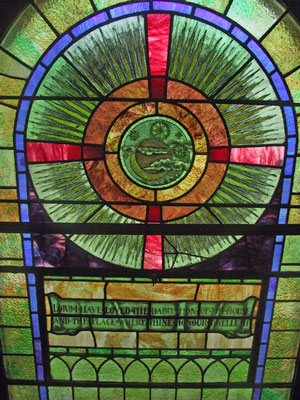
Upper Subject: Moon and Stars
Inscription: “Lord, I Have Loved The Habitation Of Thy House And The Place Where Thine Honor Dwelleth”
Dedication: Wellington and Victoria Stevens Wallace
Maker/Date: Charles E. Hogemen, 1908. Easter, 1908
Description: This is from Psalm 26:8
1Vindicate me, O Lord,
for I have walked in my integrity,
and I have trusted in the Lord without wavering.
2Prove me, O Lord, and try me;
test my heart and mind.
3For your steadfast love is before my eyes,
and I walk in faithfulness to you.*
4I do not sit with the worthless,
nor do I consort with hypocrites;
5I hate the company of evildoers,
and will not sit with the wicked.
6I wash my hands in innocence,
and go around your altar, O Lord,
7singing aloud a song of thanksgiving,
and telling all your wondrous deeds.
8O Lord, I love the house in which you dwell,
and the place where your glory abides.
9Do not sweep me away with sinners,
nor my life with the bloodthirsty,
10those in whose hands are evil devices,
and whose right hands are full of bribes.
11But as for me, I walk in my integrity;
redeem me, and be gracious to me.
12My foot stands on level ground;
in the great congregation I will bless the Lord.
This appeal to heaven my have been written by David at the time of the assassination of Ishbosheth, by Baanah and Rechab, to protest his innocence of all participation in that treacherous murder; the tenor of the Psalm certainly agrees with the supposed occasion, but it is not possible with such a slender clue to go beyond conjecture.
Symbol: Moon and Stars
To the Greeks and Roman, stars were divinities, a belief derived from Persia and Babylonia.
Heavenly bodies identified with gods to be worshiped according to the advice of astrologers. The gods as planetary figures may be represented by a star on their brow.
Christianity absorbed this idea. Christ is described as the “bright star of dawn.” (Revelation 22:16)
Early Renaissance art often shows a star on the shoulder of the Virgin’s cloak. Virgin Mary is crowned with a circle of stars. Star led the magi to the birth of Christ. The ‘ancient’ Christ of the Book of Revelation held 7 stars in his right hand
Techniques – The Wallace windows use similar glass around center symbols arranged in five rows of stone with the central theme in the middle. Surrounding the symbol are two concentric circles of stones. Within each row are different shapes of glass. The effect is traditional without any special treatment of the glass or painting.
N07
These are on the doors leading into the gallery. We think they were done at the same time as the Nativity window (1943) based on their design:
